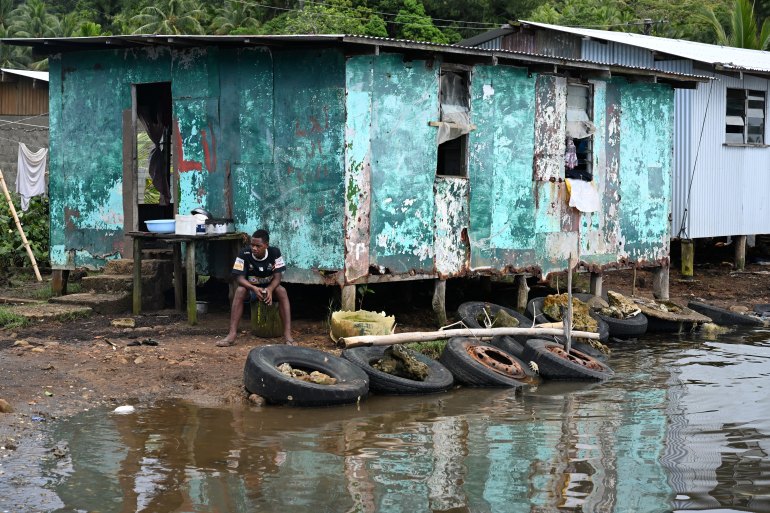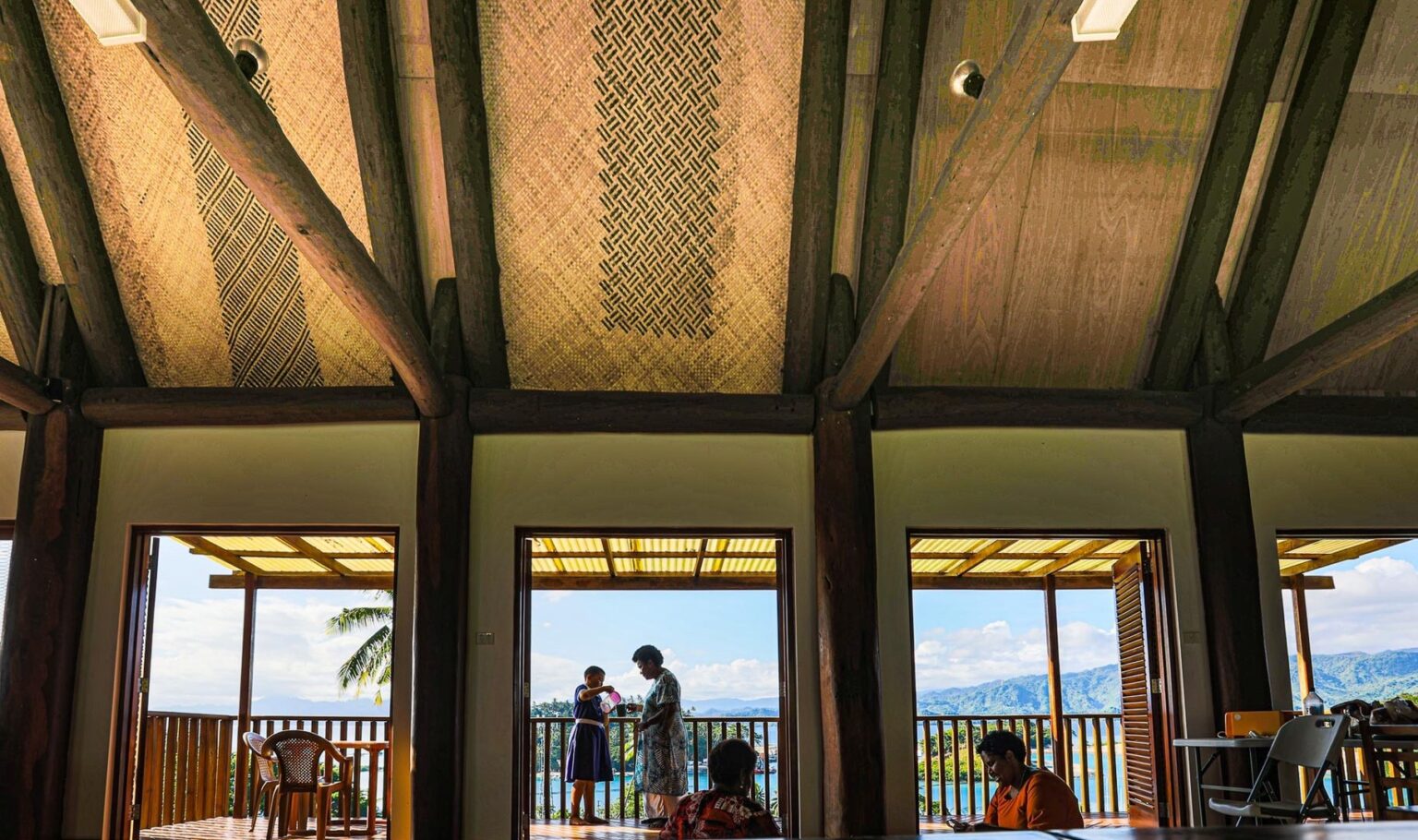Suva, Fiji – From the Arctic to the Pacific, Indigenous communities have used distinctive design and constructing methods for millennia to assist them survive in among the most difficult environments on Earth.
Now, because the UN World Meteorological Organization confirms that 2023 is ‘almost certain’ to be the most well liked 12 months on document, conventional structure’s potential is gaining worldwide consideration – for its potential to permit people to dwell in a warmer world but additionally as a result of it has much less impression on the planet.
Australian architect Peter Rankin has managed the structure agency, AAPi Design in Fiji’s capital Suva, since 2007.
“Climate change is having a major impact on the built environment,” he advised Al Jazeera. “From more frequent and severe natural disasters to rising temperatures and changing precipitation patterns. The construction and operation of buildings account for a significant portion of global energy consumption and greenhouse gas emissions, making sustainable building practices a critical component of efforts to mitigate and adapt to climate change.”
That will not be an exaggeration.
C40, a worldwide community of mayors of the world’s main cities that search to guide local weather motion, studies that the development sector alone is chargeable for greater than 23 p.c of world greenhouse gasoline emissions and consumes greater than 30 p.c of world sources. By 2050, a further 2.5 billion persons are anticipated to dwell on the planet’s cities, making the necessity for environment-friendly city infrastructure extra pressing than ever.
The fast urbanisation has additionally led to the adoption of contemporary constructing practices and supplies that always ignore or override conventional data that was linked to the local weather.

The dominance of high-rise buildings, air-con and synthetic lighting has created a big demand for vitality and sources and disrupted conventional social and cultural patterns in international locations the place individuals as soon as relied on pure air flow, shading and out of doors areas. The outcome? A constructed surroundings that’s contributing to common temperatures of 1.43 levels Celsius above pre-industrial ranges and sea ice within the Antarctic at a document low.
A United Nations Environment Programme report launched final month highlights that the 55 most climate-vulnerable economies alone have skilled losses and damages of greater than $500bn within the final 20 years. These prices are anticipated to rise steeply within the coming many years, notably within the absence of forceful mitigation and adaptation.
In a painful foreshadowing of what the long run may maintain for some Pacific nations, Australia and Tuvalu signed an unprecedented cooperation settlement in early November providing 280 Tuvaluans – 2.5 p.c of the islands’ inhabitants – everlasting residency in Australia annually. The settlement stems from a recognition that Tuvalu’s long-term future is critically endangered by local weather change. The Falepili Union covers three key facets: local weather cooperation, mobility and safety.
Following intently, French Foreign Minister Catherine Colonna stated in Canberra on Monday that she is open to any resettlement request from tiny South Pacific nations threatened by rising sea ranges, just like Australia’s current settlement with Tuvalu. Colonna stated France had watched with “great interest” final month when Australia supplied Tuvalu a lifeline to assist residents escape the rising seas and elevated storms introduced by local weather change.
This 12 months’s Pacific cyclone season – which generally runs from November 1 to April 30 – began unprecedentedly early within the South Pacific, with Cyclone Lola forming over the Santa Cruz islands, north of Vanuatu in late October. Lola’s heavy rains, damaging winds and landslips intensified much more quickly than native climate specialists had anticipated it to, making Lola solely the seventh pre-season South Pacific cyclone to kind in October since 1970.
Key to survival
For a brand new era of younger Pacific Islander architects, mitigation and adaptation are usually not summary ideas to be handled in a dystopian future; as an alternative, they kind the bedrock on which their very area’s survival relies upon. Here, conventional structure – which has been formed by the native heat, humid, and moist environmental situations – and cultural practices, can provide precious perception and options for designing buildings which might be energy-efficient, resilient to local weather extremes and environmentally pleasant.
Last November, Tualagi Nokise acquired the celebrated Architects Medallion from the New South Wales Architects Registration Board in Australia for his thesis mission – Niu Growth: The in-between. The mission centered on a hypothetical pure catastrophe analysis and coaching centre positioned off the coast of Savusavu Town in Fiji; its construction drawing on native supplies and conventional Fijian constructing methods, whereas additionally integrating fashionable cyclone rules.
The proposed framework of every constructing resembles a contemporary interpretation of a Fijian Bure – a standard picket straw-roofed hut. It is made principally of native mahogany or vesi timber, with its internal partitions and screens additionally product of regionally sourced materials, all enclosed by a thatched roof. The higher ridge of the roof is offset to a single level to scale back the impression of robust winds and the eaves are positioned nearer to the bottom to stop the roof from flying off throughout a cyclone.
A grid of cyclone roof bracing is used to supply stability, and roof trusses create openings on the decrease a part of the roof for mild, entry and cross-ventilation. A roof truss is a structural framework of triangulated timbers that gives help for a roof, utilizing as much as 40 p.c much less timber than a standard roof and thus making them extremely cost-effective. Around the buildings, planters and pebble drains naturally filter and disperse rain run-off.
“My research was profoundly influenced by my experience growing up in the Pacific, where I saw firsthand the damage left behind from these cyclones,” defined Tualagi. “Yet, as catastrophic as these were, I was fortunate enough to witness the sense of community and hope of friends and family around me; how they still smiled and shared moments together while recovering in a decimated country. Memories I take inspiration from, and my first experience with what architecture can be.”
The Fijian ‘bure’ and Samoan ‘fale’, phrases for conventional buildings, had been as soon as solely recognized by the small teams of individuals inhabiting the South Pacific, however curiosity in Indigenous constructing practices is rising.
At Stanford University within the United States, for instance, a course on Sustainable Design and Practice in Native American Architecture is particularly geared at ‘exploring the place and responsibility of Native design in combating climate change’. In Canada, The University of British Columbia’s School of Architecture lately launched a programme on Indigenous Community Planning and Design, demonstrating a worldwide hovering curiosity in conventional constructing methods.
“The stereotypical comparison of traditional buildings against modern buildings is that our traditional buildings were primitive,” added Tualagi. “This is greatly underestimating the development of form, materiality, and design strategy over generations before the colonial period. Systems and strategies promoting cross ventilation, building orientation, solar loading and water retention have been around for decades, but now we finally have an opportunity to scale; as governments are motivated to lower their carbon footprint and counter the worsening impact of flood and cyclone damage.”
That motivation, or lack thereof, has been on full show at this 12 months’s United Nations Climate Change Conference, COP28, at the moment going down in Dubai.
A UN evaluation of nationwide plans in October discovered that international locations’ local weather motion plans had been nonetheless far behind what was wanted to curb human-caused warming and restrict the devastating results of utmost warmth, storms and droughts; however that some nations had taken marginal steps in the direction of slashing emissions.
The report appeared into the local weather plans of 195 international locations and located that emissions from the burning of coal, oil and gasoline will rise by 9 p.c by 2030 in contrast with 2010 ranges, however shall be two p.c decrease than 2019 ranges due to some local weather motion from international locations switching to cleaner vitality. Climate scientists warn, nevertheless, that the world must emit about 45 p.c much less carbon emissions by 2030.
Peter Rankin is hopeful that the development sector can study to work extra successfully with governments to replace nationwide constructing codes that mitigate local weather disaster.
He additionally believes the Pacific can generate actual international momentum round hybrid-traditional design.
“Fiji and the Pacific, in general, is ripe for innovation,” he stated. “Our history, local skillset and ‘fight to survive’ places us in a unique position to be an incubation hub for accelerating the merging of more traditional knowledge and modern building design. The goal, of course, being a more resilient future for humanity.”
https://www.aljazeera.com/news/2023/12/7/can-traditional-architecture-help-build-a-more-resilient?traffic_source=rss


